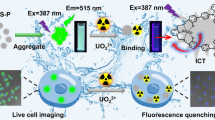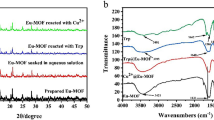Abstract
In present study, we discovered unusual solvent-mediated aggregation-enhanced emission (AEE) character of 11-mercaptoundecanoic acid capped gold nanoclusters (MUA-Au NCs). When aggregated in aqueous media, the MUA-Au NCs showed strong emission, which was weakened by adding ethanol. Interestingly, the suppressed emission was selectively enhanced in the presence of hydrogen sulfide (H2S) because H2S was absorbed onto Au NCs through the strong sulfur-gold bonding affinity. The hydrolyzed H2S, namely, HS−, made the Au NCs negatively charged, which aggregated again due to decreased solubility. The H2S-mediated fluorescence enhancement can be further amplified by introducing a hydrophilic thiolate (glutathione, GSH) onto the surface of Au NCs (GSH/MUA-Au NCs), which enabled sensitive determination of H2S. Under the optimized condition, a detection limit of 35 nM was achieved. The determination was not interfered by other anions such as F−, Cl−, Br−, I−, OAc−, N3−, NO3−, HCO3−, SCN−, SO32−, and SO42−. This excellent sensing performance allowed practical application of the GSH/MUA-Au NC-based sensing platform to accurate determination of H2S in human serum samples.

Unusual aggregation-enhanced emission character of 11-mercaptoundecanoic acid capped gold nanoclusters is discovered and has been applied for fluorometric hydrogen sulfide detection.






Similar content being viewed by others
References
Jin R, Zeng C, Zhou M, Chen Y (2016) Atomically precise colloidal metal nanoclusters and nanoparticles: fundamentals and opportunities. Chem Rev 116:10346–10413
Tao Y, Li M, Ren J, Qu X (2015) Metal nanoclusters: novel probes for diagnostic and therapeutic applications. Chem Soc Rev 44:8636–8663
Zhao J, Jin R (2018) Heterogeneous catalysis by gold and gold-based bimetal nanoclusters. Nano Today 18:86–102
Chen L-Y, Wang C-W, Yuan Z, Chang H-T (2015) Fluorescent gold nanoclusters: recent advances in sensing and imaging. Anal Chem 87:216–229
Kurashige W, Niihori Y, Sharma S, Negishi Y (2016) Precise synthesis, functionalization and application of thiolate-protected gold clusters. Coord Chem Rev 320-321:238–250
Xie J, Zheng Y, Ying JY (2010) Highly selective and ultrasensitive detection of Hg2+ based on fluorescence quenching of Au nanoclusters by Hg2+–Au+ interactions. Chem Commun 46(6):961–963
Yuan Z, Peng M, He Y, Yeung ES (2011) Functionalized fluorescent gold nanodots: synthesis and application for Pb2+ sensing. Chem Commun 47:11981–11983
Gao Y, Liu M, Yue X, Du J (2019) Ratiometric fluorometric determination of mercury(II) by exploiting its quenching effect on glutathione-stabilized and tetraphenylporphyrin modified gold nanoclusters. Microchim Acta 186:307
Yin YB, Coonrod CL, Heck KN, Lejarza F, Wong MS (2019) Microencapsulated photoluminescent gold for ppb-level chromium(VI) sensing. ACS Appl Mater Interfaces 11:17491–17500
Vasimalai N, Fernández-Argüelles MT, Espiña B (2018) Detection of sulfide using mercapto tetrazine-protected fluorescent gold nanodots: preparation of paper-based testing kit for on-site monitoring. ACS Appl Mater Interfaces 10:1634–1645
Wang L, Chen G, Zeng G, Liang J, Dong H, Yan M, Li Z, Guo Z, Tao W, Peng L (2015) Fluorescent sensing of sulfide ions based on papain-directed gold nanoclusters. New J Chem 39:9306–9312
Germain ME, Knapp MJ (2009) Optical explosives detection: from color changes to fluorescence turn-on. Chem Soc Rev 38:2543–2555
Mei J, Leung NLC, Kwok RTK, Lam JWY, Tang BZ (2015) Aggregation-induced emission: together we shine, united we soar! Chem Rev 115:11718–11940
Luo J, Xie Z, Lam JWY, Cheng L, Chen H, Qiu C, Kwok HS, Zhan X, Liu Y, Zhu D, Tang BZ (2001) Aggregation-induced emission of 1-methyl-1,2,3,4,5-pentaphenylsilole. Chem Commun 1740–1741
Luo Z, Yuan X, Yu Y, Zhang Q, Leong DT, Lee JY, Xie J (2012) From aggregation-induced emission of Au(I)–thiolate complexes to ultrabright Au(0)@Au(I)–thiolate core–shell nanoclusters. J Am Chem Soc 134:16662–16670
Santiago-Gonzalez B, Monguzzi A, Azpiroz JM, Prato M, Erratico S, Campione M, Lorenzi R, Pedrini J, Santambrogio C, Torrente Y, De Angelis F, Meinardi F, Brovelli S (2016) Permanent excimer superstructures by supramolecular networking of metal quantum clusters. Science 353:571–575
Wu Z, Du Y, Liu J, Yao Q, Chen T, Cao Y, Zhang H, Xie J (2019) Aurophilic interactions in the self-assembly of gold nanoclusters into nanoribbons with enhanced luminescence. Angew Chem Int Ed 58:8139–8144
Wang J, Lin X, Su L, Yin J, Shu T, Zhang X (2019) Chemical etching of pH-sensitive aggregation-induced emission-active gold nanoclusters for ultra-sensitive detection of cysteine. Nanoscale 11:294–300
Yahia-Ammar A, Sierra D, Mérola F, Hildebrandt N, Le Guével X (2016) Self-assembled gold nanoclusters for bright fluorescence imaging and enhanced drug delivery. ACS Nano 10:2591–2599
You J-G, Tseng W-L (2019) Peptide-induced aggregation of glutathione-capped gold nanoclusters: a new strategy for designing aggregation-induced enhanced emission probes. Anal Chim Acta 1078:101–111
You J-G, Lu C-Y, Krishna Kumar AS, Tseng W-L (2018) Cerium(III)-directed assembly of glutathione-capped gold nanoclusters for sensing and imaging of alkaline phosphatase-mediated hydrolysis of adenosine triphosphate. Nanoscale 10:17691–17698
Shan J, Wei L, Daqiao H, Xuejuan Z, Xi K, Wenjun D, Shuang C, Shiqiang W, Shuxin W, Manzhou Z (2018) Aggregation-induced emission (AIE) in Ag−Au bimetallic nanocluster. Chem Eur J 24:3712–3715
Pyo K, Thanthirige VD, Kwak K, Pandurangan P, Ramakrishna G, Lee D (2015) Ultrabright luminescence from gold nanoclusters: rigidifying the Au(I)–thiolate shell. J Am Chem Soc 137:8244–8250
Yuan Z, Du Y, Tseng Y-T, Peng M, Cai N, He Y, Chang H-T, Yeung ES (2015) Fluorescent gold nanodots based sensor array for proteins discrimination. Anal Chem 87:4253–4259
Huang C-C, Yang Z, Lee K-H, Chang H-T (2007) Synthesis of highly fluorescent gold nanoparticles for sensing mercury(II). Angew Chem Int Ed 46:6824–6828
Guo Y, Tong X, Ji L, Wang Z, Wang H, Hu J, Pei R (2015) Visual detection of Ca2+ based on aggregation-induced emission of Au(I)-Cys complexes with superb selectivity. Chem Commun 51:596–598
Lu X, Wang T, Shu T, Qu X, Zhang X, Liang F, Su L (2016) Combination of chemical etching of gold nanoclusters with aggregation-induced emission for preparation of new phosphors for the development of UV-driven phosphor-converted white light-emitting diodes. J Mater Chem C 4:11482–11487
Yuan Z, Peng M, Shi L, Du Y, Cai N, He Y, Chang H-T, Yeung ES (2013) Disassembly mediated fluorescence recovery of gold nanodots for selective sulfide sensing. Nanoscale 5:4683–4686
Kozawa D, Kumar R, Carvalho A, Kumar Amara K, Zhao W, Wang S, Toh M, Ribeiro RM, Castro Neto AH, Matsuda K, Eda G (2014) Photocarrier relaxation pathway in two-dimensional semiconducting transition metal dichalcogenides. Nat Commun 5:4543
Yuan Z, Lu F, Peng M, Wang C-W, Tseng Y-T, Du Y, Cai N, Lien C-W, Chang H-T, He Y, Yeung ES (2015) Selective colorimetric detection of hydrogen sulfide based on primary amine-active ester cross-linking of gold nanoparticles. Anal Chem 87:7267–7273
Jin M, Huang L, Tang Y, Wang G, Ma Z, Yuan Z, Lu C (2019) Rapid sulfite screening using nitrobenzofurazan anchored asymmetric naphthorhodamine via electrostatic attraction mediated reaction kinetics. Sensors Actuators B Chem 297:126748
Bitziou E, Joseph MB, Read TL, Palmer N, Mollart T, Newton ME, Macpherson JV (2014) In situ optimization of pH for parts-per-billion electrochemical detection of dissolved hydrogen sulfide using boron doped diamond flow electrodes. Anal Chem 86:10834–10840
Wen Z, Song S, Hu T, Wang C, Qu F, Wang P, Yang M (2019) A dual emission nanocomposite prepared from copper nanoclusters and carbon dots as a ratiometric fluorescent probe for sulfide and gaseous H2S. Microchim Acta 186:258
Liu J, Bao H, Ma D-L, Leung C-H (2019) Silver nanoclusters functionalized with Ce(III) ions are a viable “turn-on-off” fluorescent probe for sulfide. Microchim Acta 186:16
Zhang X, Zhou W, Yuan Z, Lu C (2015) Colorimetric detection of biological hydrogen sulfide using fluorosurfactant functionalized gold nanorods. Analyst 140:7443–7450
Chang H-Y, Chang H-T, Hung Y-L, Hsiung T-M, Lin Y-W, Huang C-C (2013) Ligand effect on the luminescence of gold nanodots and its application for detection of total mercury ions in biological samples. RSC Adv 3:4588–4597
Chen L, Huang P, Tan H, Wang L (2017) A terbium(III)-based coordination polymer for time-resolved determination of hydrogen sulfide in human serum via displacement of copper(II). Anal Methods 9:1004–1010
Funding
This work was supported by the National Natural Science Foundation of China (21605003, 21521005, and 21575010), the Fundamental Research Funds for the Central Universities (buctrc201619), the Open Research Fund Program of Beijing Key Lab of Plant Resource Research and Development, Beijing Technology and Business University (PRRD-2018-YB3).
Author information
Authors and Affiliations
Corresponding authors
Ethics declarations
Conflict of interest
The authors declare no competing financial interest.
Additional information
Publisher’s note
Springer Nature remains neutral with regard to jurisdictional claims in published maps and institutional affiliations.
Electronic supplementary material
ESM 1
(DOCX 614 kb)
Rights and permissions
About this article
Cite this article
Lu, F., Yang, H., Tang, Y. et al. 11-Mercaptoundecanoic acid capped gold nanoclusters with unusual aggregation-enhanced emission for selective fluorometric hydrogen sulfide determination. Microchim Acta 187, 200 (2020). https://doi.org/10.1007/s00604-020-4159-1
Received:
Accepted:
Published:
DOI: https://doi.org/10.1007/s00604-020-4159-1




